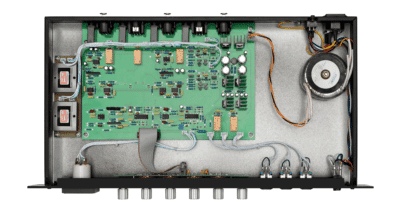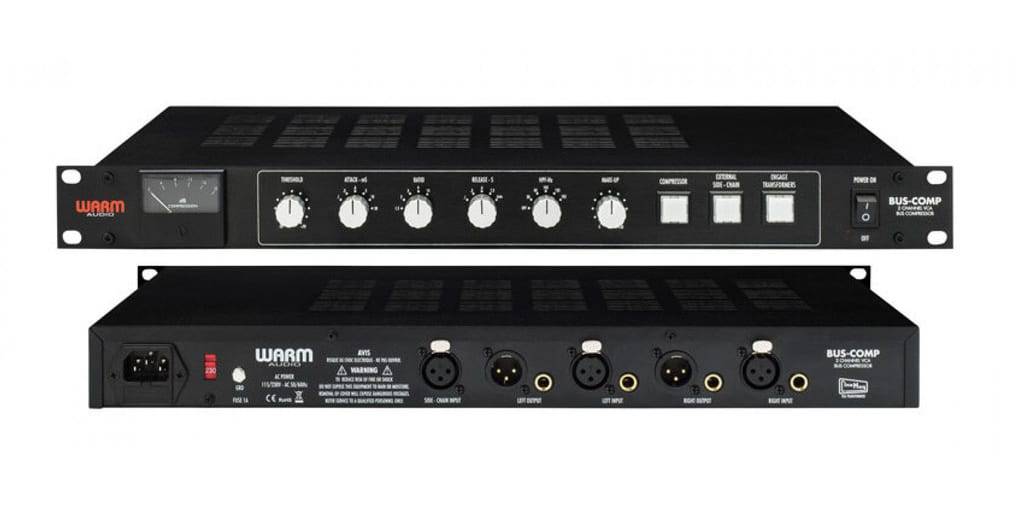Making a Scene Reviews Warm Audio’s Bus Compressor
Making a Scene Brings you a Review of the
Warm Audio 2 Channel VCA Bus Compressor!
What is a VCA Compressor?
Before we get into reviewing the Warm Audio 2 Channel VCA Bus Compressor, lets take a look at what a VCA compressor is and why you would want one.
Even though the compressor is controlled by a Voltage controlled Amplifier, it should be looked at more as an attenuator. Simply stated the signal is split into a carrier signal and an Modulator signal. The Carrier is the Audio signal that is run through the compressor and the Modulator signal is sent into the VCA Circuit where it gets converted into a “DC” voltage. The Louder the audio Signal is the higher the DC Voltage is created by the VCA Circuit. This voltage is used to turn the signal down when it reaches a certain level.
In simple terms, that’s how the gain reduction takes place in a VCA compressor; a control signal which you dial in using the different front panel controls like Threshold, Attack, Ratio and Release, tell the VCA circuit in the compressor when to start turning the signal down, how fast to do it, how much to do it, and how long it should take for the signal volume to return to normal. The Louder the signal going into the compressor the more control voltage is created and more attenuation is made available.
Advantages of a VCA Compressor
There are a few advantages that VCA type compressors have over other types of compressors.
- They are very low distortion type compressors.
- They have a very Fast Attack and Release times
- They are capable of very high levels of Gain Reduction
- They are extremely transparent
Uses for VCA Compressors
Audio Engineers quickly learned the VCA Compressor was ideal when used on the mix or on stereo busses to give their mixes that “Glue”. The sonic cohesiveness, that can make the difference between a professional sounding mix or mastered recording and one that just seems to be missing something. Some of the high end console manufacturers like SSL, API and Neve recognized the importance of the VCA compressor and in turn created some of the recording industries most iconic units that used this type of circuit.
The Warm Audio VCA Compressor
 The Warm Audio bus compressor uses an all-analog circuit that is based on the vintage VCA circuitry that has been used in the industry for decades. Acknowledging the fact Stereo VCA bus compressors are masterful at controlling dynamics they made their unit a discreet 2 channel, stereo VCA bus compressor.
The Warm Audio bus compressor uses an all-analog circuit that is based on the vintage VCA circuitry that has been used in the industry for decades. Acknowledging the fact Stereo VCA bus compressors are masterful at controlling dynamics they made their unit a discreet 2 channel, stereo VCA bus compressor.
In addition to the vintage analog circuitry that has been tested over time,
Warm Audio has added some modern and Unique features that sets this unit apart from it’s contemporaries. One of which is the addition of two CineMag transformers, which are driven by fully discreet Op amps, that you can switch into the signal path to add the warm that Iron core transformers can give you! This adds to the great sonic character to the sound of the vintage VCA sound.

The front panel controls should be familiar to anyone who has used compressors before.
The Threshold, which determines at which level the compression begins is variable between -20db to +20db.
All the additional controls are detent and have preset steps as opposed to a fully variable settings.
The Attack, which determines how fast the compression begins compressing the source, is set in increments of .1ms, .3ms, .6ms, 3ms, 10ms and 30ms.
The Ratio, which sets the amount of compression applied, has preset settings for 1:1 2:1 3:1 4:1 and 10:1
The Release, which determines how fast the compression recovers after the signal goes below the threshold has settings for .1 seconds, .2 Seconds, .3 Seconds, 1.2 seconds and Auto. The Auto setting allows the source material to determine what the release time should be.
There is also a High Pass Filter (HPF) that can be set to 30, 60, 105, 125 or 185Hz. The filter affects the audio entering the VCA so that only frequencies above the filter point will be used as a control source for compression, This is an extremely useful feature as it allows the compressor to ignore low-frequency content of the mix that might create unwanted compression effects such as pumping.
This is rounded out with the Make up Gain which allows you to adjust the final output volume to make up for any loss of volume from the action of the compressor.
There are three push buttons that allow you to Engage the compressor or bypass it, Engage or bypass the Transformers and finally Engage or bypass the external sidechain.
Finally there is a VU meter to give you an indication of the amount of compression is being applied.

The inputs and outputs of the unit have both XLR and 1/4″ TRS connections to accommodate any type of installation. The Sidechain input is an XLR connection.
Integrating the Bus Compressor in my Studio
Many home studios today work and mix completely “in the box”. You need to understand that this unit is an analog unit that requires you to come out of the box to effectively use it. Whether you output your stereo mix through an external mixer or you send a stereo mix out of your DAW to your converters, you will need to send the stereo signal into this unit and then record the output back into your DAW as a stereo signal.
The way I integrated this unit into my system is I placed it into my rack and wired it directly into my patch bay. My studio has a 24 channel output converter (MOTU 24i0) where I take the first 16 channels and send them to a passive summing unit which sums the signal to a stereo output that goes to my patch bay. I can now patch the output of the of that summing unit into any of my preamps then I can then patch it into the Bus Compressor and then from the bus compressor back into my DAW which records the Mixed or Mastered signal.
How does it Perform
I have several projects that were recorded prior to the pandemic, that were mixed, Mastered and ready to be released by the client. The first test was sending a mix session through the summing unit into a Warm Audio WA 273 Then into the Bus compressor which was then routed back into my DAW. I recorded one mix with the compressor bypassed, one with the compressor engaged and then one more with the compressor and the transformers engaged.
I set the compressor to a 2:1 compression ratio with a .1 attack and auto release. The threshold was set so I was getting between 8 and 10 db of compression on the meter. I set the makeup gain so the bypassed mix and the compressed mix were close in volume.
Each was recorded and exported as 96khz 24bit Wav files which I then set them up so I can switch between them and compare them to each other. I wanted to listen to a finished product as opposed to a live switch. I find the final exported project is the real test of how effective an external unit can be.
In My mix room I listened to the mixes with a pair of Focal Alpha 80‘s which are great for critical listening and mastering.
When I compared the mix without the bus compressor to the mix with the compressor engaged there was a subtle yet defined sense of depth and punch to the mix that was apparent. Everything seemed more real, if that makes sense to you, more present. When the transformer was added to the mix the high end seemed to attain a creamy kind of texture to it that not only seemed to allow it to be defined a bit more but also seemed to push the high end up front a bit in a pleasing way.
Conclusion
I am going to be upfront with you, I am a fan of Warm Audio and have been since my first unit I purchased from them. I have several of the microphones, preamps and compressors. Their build quality has always been well beyond their price point and the VCA 2 Channel Bus Compressor is no exception. I have always wanted to add a VCA Bus Compressor to my studio setup but most of the units on the market were well out of reach of my budget. When Warm Audio came out with their unit at a street price of $699 I knew it was my chance to add this valuable tool to my setup.
The Home Studio is going to be an essential tool for the independent artist, especially as the consumer’s perception of recorded music moves from a product they use to purchase to a service that is available 24/7 for free. To economically create and record music in your own studio will no longer be a luxury. Those of you who have started to build your own studio and have been working strictly in the box, may want to explore the warmth and character of using a true analog tool in your mixing and mastering. There are a few tools that I would consider essential to reaching a professionally polished mix, the Warm Audio Bus compressor is one of those tools.
Buy Us a Cup of Coffee!
Join the movement in supporting Making a Scene, the premier independent resource for both emerging musicians and the dedicated fans who champion them.
We showcase this vibrant community that celebrates the raw talent and creative spirit driving the music industry forward. From insightful articles and in-depth interviews to exclusive content and insider tips, Making a Scene empowers artists to thrive and fans to discover their next favorite sound.
Together, let’s amplify the voices of independent musicians and forge unforgettable connections through the power of music
Make a one-time donation
Make a monthly donation
Make a yearly donation
Buy us a cup of Coffee!
Or enter a custom amount
Your contribution is appreciated.
Your contribution is appreciated.
Your contribution is appreciated.
DonateDonate monthlyDonate yearlyYou can donate directly through Paypal!
Subscribe to Our Newsletter
 |  Spotify |  Deezer | Breaker |
 Pocket Cast |  Radio Public |  Stitcher |  TuneIn |
 IHeart Radio |  Mixcloud |  PlayerFM |  Amazon |
 Jiosaavn |  Gaana | Vurbl |  Audius |
Reason.Fm | |||
Find our Podcasts on these outlets
Discover more from Making A Scene!
Subscribe to get the latest posts sent to your email.














































